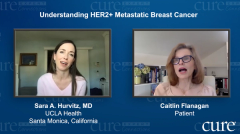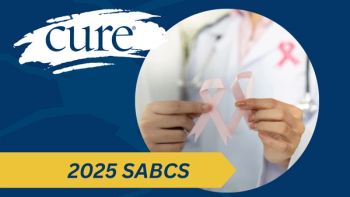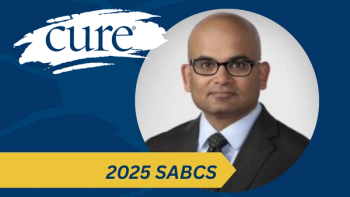
Progression of HER2+ Metastatic Breast Cancer
Caitlin Flanagan, a patient with HER2+ metastatic breast cancer, shares the hope she had after progression because of the ongoing research for HER2+ breast cancer, and Sara A. Hurvitz, M.D., reviews the drug regimens available in this realm.
Episodes in this series

Sara A. Hurvitz, M.D.: Can you tell us a little bit? You did have a progression. We were both a little surprised. I was thinking that you might have been the 1%-er cure.
Caitlin Flanagan: I was like this super responder.
Sara A. Hurvitz, M.D.: Yes. You were a super responder.
Caitlin Flanagan: I was. And look at me. I’m alive. That’s pretty super.
Sara A. Hurvitz, M.D.: That’s right. So, what happened? Tell them.
Caitlin Flanagan: I remember that journey of HER2 [human epidermal growth factor receptor 2]/neu and Herceptin and these wonderful new medications. When I first got diagnosed, the only bit of good news that I had was that it wasn’t stage 4. But I was told, “This is aggressive cancer. It’s stage 3. We didn’t get clean margins. We had to go in again for a second lumpectomy.”
Then the doctor said something about HER2/neu, and I asked, “Well, what’s that?” At that point, it was a bad finding. He tried to sugarcoat it a bit, but that was another bit of terror. I thought, “How could this be so bad?” You don’t believe that you’re going to be that person. Obviously, some people have to get cancer. There’s no reason why you shouldn’t be one of them, but you just don’t believe it’s going to be you. Then to find out it was just so bad.
But then over the years, as you all were doing more and more research, it became one of the better forms of serious breast cancer to have because there were all these treatments. I try not to make too much meaning out of things, because I really believe cancer is a mutation; there are treatments. The treatments may or may not work. It has nothing to do with being a good person or any of that, fortunately, or I’d be dead yesterday. Ironically, even though I was heading into this progression situation, I was aware that things were getting better and better, and I felt that was miraculous. It’s an incredible thing to know that my serious disease was still being studied and new advances were coming along. So I wasn’t that frightened.
Sara A. Hurvitz, M.D.: So you felt a sense of hope, even before you were diagnosed with progression.
Caitlin Flanagan: Definitely.
Sara A. Hurvitz, M.D.: There was a little confusion about your progression at the time because you also have another autoimmune situation that can kind of look like a progression event, but it turned out that it was growing again in your lungs. By way of background—before we go into the treatment decisions that you made at the time of progression—when a patient has the HER2 amplification or HER2 overexpression in their tumor, it’s important to always keep the brakes on HER2.
We now have a total of eight HER2-targeted therapies for metastatic HER2-positive breast cancer that are FDA-approved. We have drugs that are pills that can get into the inside of the cell and target the inside of the HER2 receptor. There are three such medicines: lapatinib, neratinib, and now tucatinib. We have three antibodies. Herceptin is an antibody. It targets the outside of the receptor. It’s also known as trastuzumab. We also have pertuzumab, or Perjeta. Just in the last month, margetuximab was FDA-approved. We also have two antibody-drug conjugates: trastuzumab emtansine, or TDM1, and trastuzumab deruxtecan, or TDXd, which was FDA-approved in the last year. There is a lot of movement in this field, because this is a cancer that is unique because we know what’s driving it.
Sometimes we’ll give other medicines along with the HER2-targeted therapy, like chemotherapy or anti-estrogen therapy, in the case that hormone receptors are co-expressed. There are a lot of treatment options available for patients. The important thing is as long as the patient’s performance status, functional status, ability to participate in life—get out of bed, brush their teeth, do their hair, feed themselves, light housework, writing, doing day-to-day life—remains, then we should have a therapy for that person, especially with HER2+ breast cancer. When you had your progression, we sat down and went through a variety of options, kind of like we did when you were originally diagnosed, although we had far fewer options at that time than we did when we sat down. Do you recall how we went through that, what goals you had, and what factors were important to you in selecting a therapy?
Caitlin Flanagan: Well, I would never question Dr. Sara Hurvitz. That time 10 years ago, it was six treatments. We were to come in at the third treatment to see how it was doing. I was terrified to go in to find out the results. We booked a room at a really nice hotel by your office, Casa Del Mar, and we thought, “No matter what, we’re going to go to Casa Del Mar and just have a cocktail.” I thought, “If it can just be that it hasn’t progressed, that would be good news. If it’s stable, that would be good news.” You bounced in and you said, “There’s no evidence of disease on your scan.” That news was so miraculous to us. We hadn’t even thought to put that on the wish list.
After that, I’m not one to pitch in my 2 cents on the treatments. You knew a lot of treatments, and you were talking through them. I said, “I would like you to make the recommendation of what you think the best one is.” You chose one, and I didn’t feel really sick on it, but I didn’t feel great. You had told me that there were so many others and we could change. But I thought, “Well, if I feel this sick, it must be working.” But I just didn’t feel well at all. Then I told you, and you said, “Oh no, there are so many others. You have to have quality of life, too,” and you found another one that worked for about a year that was super easy to tolerate. I feel like I don’t have a very precise notion. I know you have a precise notion.
Sara A. Hurvitz, M.D.: It’s funny, because there’s a spectrum of patients, just like there’s a spectrum of doctors. Some patients want to research everything, read all of the information, and have a real say in what therapy they’re going to go on. That’s great when patients want to do that. I prefer to give them the literature to read, rather than having them go to maybe less reliable websites or blogs for their information. There are some patients who really want to be an active participant in the decision-making, and then there are those patients who say, “Look, I really don’t want to feel nauseous. I’d really like to save my hair. What are the options within that?” You did that a little bit, where it was like, “Is it a pill? Is it IV [intravenous]? Am I going to be sick? Am I going to lose my hair?” But you were more interested in saying, “OK, what’s your recommendation? I’ll go with it.”
Caitlin Flanagan: No judgment at all, but women who don’t have a science or medical background can go all out learning, because that’s their style of approaching problems. They can put themselves way off base, because now you’ve wasted a lot of time in your appointment with your doctor. She’s got to tell you, “Well, these events, superseded by these other things.” We’re not medical doctors just because we have the disease. Once you’ve met with your doctor and made a decision with your doctor, then you could learn more about it. But unless you really have a lot of knowledge, you’re just going to be thrown into the internet and chat rooms and terror. That’s the way some women go, but it’s not my way.
Transcript edited for clarity.





